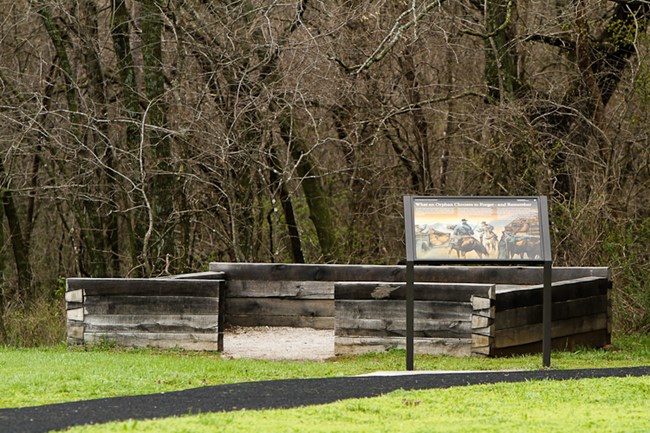Last updated: March 6, 2023
Article
Finding George Washington Carver’s Birthplace

NPS photo.
George Washington Carver’s remarkable life began on a homestead established by Moses Carver near Diamond Grove, Missouri. Moses purchased a woman, Mary, in 1855 who gave birth to George - later George Washington Carver - in the early 1860s. Moses had built a log cabin in 1838 for his family; it became Mary’s family’s home. A new cabin was constructed nearby by 1860, before a frame plantation house was erected farther away around 1890.
Carver's Childhood
When George was about six weeks old, a gang of night riders kidnapped him and his mother. Moses sent a rescuing party after them, but they only recovered George. Moses adopted George into his own family and provided him with an education.
Locals later recalled George as being the most intelligent little boy they had ever met. When George was ten years old, he moved several miles away to attend school, which placed him on a path to becoming a renowned scientist and inventor. He is revered today for inventing hundreds of products - many peanut-based - including plastics, paints, dyes, and fuel; for teaching students at the Tuskegee Institute how to re-shape southern agriculture; and for being a great force in racial understanding.
George died on January 5, 1943. That July, Congress authorized the creation of George Washington Carver National Monument to celebrate his life. But by the time that the national monument was finally established in 1951, the cabin had long since deteriorated.
Locating Carver's Birthplace
NPS archeologists spoke with local residents who remembered where the cabin and other buildings had stood, because they had lived in them in the 20th century. They recalled that the cabin had one room and stood near a second cabin, on the north side of a creek in a clearing of trees. A nephew of Moses’s remembered that the log cabin in which George was born faced the east. It had a single window in the west wall and a chimney on the north side. It was built of hewn oak logs. The cracks were filled with clay or chinking. The cabin had a clapboard roof. Its plank door had wooden hinges.
Archeologists focused their excavation on the area identified by locals as having been the "slave cabin." Although they identified no structural evidence of the cabin, the combination of artifactual evidence and locals’ testimony convinced them that they had located George’s birthplace. Artifacts conveyed everyday in the mid-nineteenth century: fragments of chinking, glazed brick, crockery, plain white porcelain dishes, square nails, lamp chimneys, bottles, and tumblers as well as beads, buttons, a fragment of a school slate, and pieces of metal cookware. They wondered if George, who was interested in marbles as a boy, had used two marbles found during excavations near the plantation house.
George later said, “From a child I had an inordinate desire for knowledge, and especially music, painting, flowers, and the sciences.” Through archeology, we can visit the precise place where his extraordinary achievements have their roots.
For More Information
Beaubien, Paul L. and Merrill J. Mattes, "George Washington Carver National Monument: The Archeological Search for George Washington Carver's Birthplace," The Negro History Bulletin
Garrison, Ervan G. "Archaeologeophysical and Geochemical Studies at George Washington Carver National Monument, Diamond, Missouri," Historical Archaeology, 1996, 30(2):22-40.
